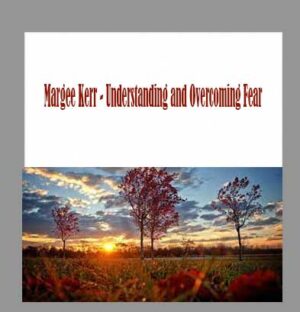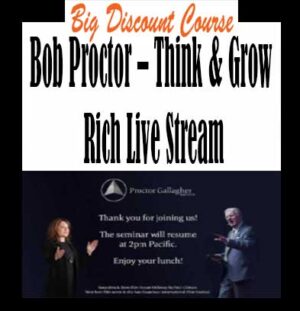Description
Michael Carasik – Biblical Hebrew: Learning a Sacred Language download, Michael Carasik – Biblical Hebrew: Learning a Sacred Language review, Michael Carasik – Biblical Hebrew: Learning a Sacred Language free
Michael Carasik – Biblical Hebrew: Learning a Sacred Language
Biblical Hebrew: Learning a Sacred Language
Learn how to read the Hebrew Bible in its original ancient language.
LESSON (36)
01:Studying Biblical Hebrew
Use the word “hallelujah†as a gateway to exploring the three different components of the Biblical Hebrew writing system: letters, vowels, and diacriticals. Then, start learning Hebrew the natural way with a look at Genesis 1:3 and the first thing God does in creating heaven and Earth.
02:Learning the Aleph Bet
Get to know the letters of the Hebrew alphabet, and how Biblical Hebrew is pronounced. Surprises include the silent letter aleph (the first letter of “Godâ€), the tricky letter samekh, which resembles an “o†but sounds like an “s,†and nearly identical pairs of letters such as gimel and nun.
03:The Tiberian Vowel System
The Tiberian system of marking vowels in Hebrew has been used exclusively for more than 1,000 years. In this lecture, discover the signs that mark short and long vowels, and learn how vowels can change their spelling (and, slightly, their sound) without changing their meaning.
04:Roots of Semitic Verbs
Every Hebrew verb, and almost every noun and adjective, is based on a root, a group of three (or sometimes two) consonants. Here, Professor Carasik teaches you how to begin recognizing the roots of verbs in Biblical Hebrew—then discusses how God is referred to in the Hebrew Bible.
05:Hebrew Verb Forms and the Definite Article
Get an introduction to the five different Hebrew verb forms: finite, infinitive, adjective, participle, and imperative. Plus, learn three ways of identifying something as definite (rather than indefinite): by using the definite article (ha), by labeling it with a personal pronoun, and by naming it.
06:Hebrew’s Attached Prepositions
Explore three Hebrew letters that attach to the beginning of other words to create a new word. Then, armed with this new knowledge, read your first complete paragraph in Biblical Hebrew from start to finish: the story of the first day of creation in Genesis 1:1-5.
07:Adjective Forms and Agreement in Hebrew
Unlike English, Hebrew adjectives have four forms, not one—and they must agree with their nouns based on whether they’re singular or plural, and masculine or feminine. Learn the four forms of adjectives (tov, tovah, tovim, tovot), several adjectives, and two ways to put nouns and adjectives together.
08:Irregular Hebrew Nouns and Adjectives
Sometimes it’s the simpler nouns that are the most likely to surprise you. Examine several of the most common non-obvious nouns (irregular nouns) and adjectives (demonstratives) in Biblical Hebrew. These include family names (daughter, son, brother), as well as “this†(zeh, zot) and “these†(éleh).
09:Hebrew Pronouns and Pronominal Suffixes
Hebrew has a ton of different pronouns. In this lecture, get an introduction to pronouns like “I†(ani, anokhi) and “we†(anahnu), as well as three different flavors of pronominal suffixes. Then, practice your new skills with a Bible verse describing the fourth day of creation.
10:How Hebrew Letters Behave
What do different letters do differently? Here, take a comprehensive look at the different ways Hebrew letters behave and start deciphering words in Biblical Hebrew that you don’t already recognize. Topics include guttural letters (the orneriest consonants in the Hebrew language) and roots that start with yud.
11:Perfect and Imperfect Hebrew Verbs
Focus on two of the five forms of Biblical Hebrew verbs: the perfect and the imperfect, both of which have person, gender, and number. The perfect, as you’ll learn, is always marked by endings. The imperfect, however, is marked by prefix letters as well: aleph, nun, tav, and yud.
12:Segholate Nouns and Pausal Forms
Turn now to segholate nouns—nouns that feature seghols (“-eh†vowels). By looking at segholate nouns in real Hebrew phrases from the Bible, you’ll start to get more comfortable with what Professor Carasik calls the “EH-eh rhythm†and the various grammatical forms that use the pattern.
13:The Construct Form: Hebrew’s Trailer Hitch
By allowing you to attach another noun to your first noun, the construct form acts as a sort of trailer hitch in Biblical Hebrew. Once attached, the first noun in construct “belongs†to the second. Here, learn construct forms by revisiting the first and fourth day of creation.
14:Forming Hebrew Construct Chains
Continue your study of construct forms with prepositions in Biblical Hebrew that are combinations of simple prepositions you’ve already learned (example: lifnei, or “beforeâ€). Then, look at irregular nouns with unusual construct forms whose frequent occurrence makes them critical to understanding Biblical Hebrew.
15:Hebrew Verb Classifications: Binyanim
In Biblical Hebrew, the binyan acts as a sort of stem or conjugation for verbs. Get a re-introduction to verbs with their binyan identification, learn how the binyanim got their names, and focus on a single root in different binyanim to get a feel for what the binyanim do to a verb’s meaning.
16:Question Words in Hebrew
From mi (“Who?â€) and lama lo (“Why not?â€) to eikh (“How?â€) and matai (“When?â€), discover how to recognize the words that tell you when a question is coming up in Biblical Hebrew. Why is this so important? Because there’s no such thing as a question mark in Biblical Hebrew.
17:Hebrew Participles
Return to the verbal system with Professor Carasik’s helpful explanation of the third of the five Hebrew verb forms: the participle. One of the ways you’ll master the verbal adjective in Biblical Hebrew is by working your way through Genesis 22:7.
18:Counting in Hebrew
In this fun lecture, start to count in Hebrew, from one to 10,000. You’ll learn a children’s rhyme for counting from one to four, the construct form of numbers, the ordinal numbers, some helpful shortcuts such as how to refer to a “pair†of something, and more.
19:Hebrew Roots with Guttural Letters
Focus your attention here on categories of verbs from the Qal binyan with roots whose guttural letters (hey, het, and ayin) tend to “misbehave.†Central to this lecture are three rules about how gutturals behave, as well as relevant examples in passages from the Hebrew Bible.
20:Hebrew’s Lamed-Hey Roots
Lamed-hey roots are those roots where, in the dictionary, the third radical of a verb (the lamed) is a hey. Here, learn how to work with some of the most common lamed-hey roots, including banah (“buildâ€), hayah (“liveâ€), anah (“answerâ€), panah (“turnâ€), and kalah (“be overâ€).
21:Hebrew’s Roots Beginning with Yud
Roots that begin with yud are plentiful in Hebrew—and very common. Professor Carasik walks you through a list of some of the most common first-yud verbs, including yada (“knowâ€), yatza (“go outâ€), yarash (“take possessionâ€), and yashav (“settleâ€).
22:Irregular Hebrew Verbs
Very few verbs in Hebrew are irregular. Those that are, as you’ll learn here, are not very difficult—but they do work a little differently than what you’re used to seeing. In this lecture, learn how to master irregular Hebrew verbs by focusing on them individually.
23:Hebrew’s Hollow Verbs
Welcome to what may be the strangest verb roots of all: those that have only two consonants, not three. Here, explore the general rules about these hollow verbs, and build a list of commonly used hollow verbs you can refer to when reading Biblical Hebrew.
24:The Infinitive in Hebrew
The infinitive verb form is used to describe the action of a verb (as in “There’s a time to rend … and a time to mend.â€). Professor Carasik walks you through the different infinitive forms, then guides you through Ecclesiastes 3—what he calls the “mother lode†of the Hebrew infinitive.
25:Jussives, Cohortatives, and “Hava Nagilaâ€
Explore how Biblical Hebrew expresses intention (as in phrases like yehi or, or “Let there be light.â€). You’ll encounter jussives, which are only found in lamed-hey, hollow, and Hiphil verbs; and cohortatives, which invite collective action (as in the famous song, “Hava Nagilaâ€).
26:The Imperative Form in Hebrew
Turn now to the imperative form in Hebrew and the simplest way to think of it (in the Qal): by taking off the tav prefix from second-person imperfect verbs. You’ll learn imperatives from a variety of weak and strong verbs, and use your skills to work through several biblical verses.
27:Verbs of the Hiphil Binyan
Focus on a new binyan: Hiphil, which can be thought of as the causative binyan. (One example: l’haqtir, or “to burn incense.â€) Then, go back to Genesis, collect a list of Hiphil infinitives, and see what the different root categories do when you put them into this Hiphil shape.
28:Piel Verbs and Passive Binyanim
Take a closer look at another major binyan: the Piel. The goal of this lecture is to give you the skills to distinguish this binyan when you need to, so you can learn the verbs as they come along. Then, examine two more binyanim: the passives Pu’al and Hophal.
29:Reflexive Binyanim: Niphal and Hitpa’el
Conclude your survey of the seven different binyanim by taking a closer look at two reflexive patterns: the Niphal and the Hitpa’el. Along the way, Professor Carasik introduces you to an important root that appears only in these two binyanim: nun-bet-aleph, or “to be/act like a prophet.â€
30:Reading the Bible in Hebrew: Joshua 1
Now you’re ready to start reading longer passages in the Bible in Hebrew. Here, follow Professor Carasik as you read Joshua 1:1-9, which deals with God’s charge to Joshua. You’ll translate the text, talk about the passage’s meaning, and spend time parsing every single verb it contains.
31:Geminate Verbs and Reading Numbers 22
In this lecture, explore geminates: roots where radicals two and three are the same. Along the way, you’ll learn how to spot these common two-letter combinations, consider a fascinating example from Ezekiel’s vision of the messianic future Temple, and begin reading Numbers 22 from start to finish.
32:Hebrew’s Object Suffixes
You’ve seen object suffixes in previous lectures. Now, focus on them directly. You’ll learn some obvious (and not-so-obvious) combinations of verbs and object suffixes, and ponder some questions about phrases and sentences in the Bible that appear more than once, but with slight variations.
33:Hebrew Oaths and Other Idioms
Study idioms that are common in Biblical Hebrew, but sound strange when translated into English. You’ll explore different ways to take an oath in Biblical Hebrew, the customary way to state someone’s age, and the danger of “crossing the mouth†of the Lord.
34:Understanding Hebrew Punctuation Marks
In the Hebrew Bible, every word has a punctuation mark that serves three functions: telling you where the accent falls, indicating how to chant the text musically, and telling you how to group words in a sensible way. Use this knowledge to move forward in your reading of Numbers 22.
35:Choosing a Hebrew Bible
What’s the best Bible from which to read Hebrew? Professor Carasik offers insights and recommendations on four printed Bibles as well as several electronic sources, and shows you how to navigate your way to a specific chapter and verse in an all-Hebrew Bible. Close by resuming your reading of Numbers 22.
36:Helpful Hebrew Reference Books
Look at some essential Hebrew reference books out there (besides biblical translations and commentaries), including reference grammars and three major Biblical Hebrew dictionaries. Close out the course by completing your line-by-line reading of Numbers 22.
DETAILS
Overview
Get an authoritative primer on a fascinating ancient tongue with Biblical Hebrew: Learning a Sacred Language. Covering everything from the Hebrew alphabet and punctuation marks to essential vocabulary words to advanced grammatical rules, Professor Michael Carasik’s 36 lectures equip you to read one of the world’s greatest books in its original language on your own.
About
Michael Carasik
“Reading the Bible in Hebrew is like traveling back in time. You can hear voices from 2500 years ago speaking directly to you.â€
ALMA MATERÂ Brandeis University
INSTITUTIONÂ University of Pennsylvania
Dr. Michael Carasik has taught Biblical Hebrew since 1991 and is currently adjunct assistant professor of Biblical Hebrew at the University of Pennsylvania, where he has taught since 2000. He earned his PhD in Bible and Ancient Near East from Brandeis University. A member of the University of Pennsylvania’s Faculty Working Group on Recovered Language Pedagogies, Professor Carasik has also taught at Hebrew College, Northeastern University, the University of Delaware, Gratz College, the Reconstructionist Rabbinical College, and Saint Joseph’s University. In addition, he has taught adults in the Kerem, Melton, and Me’ah/ConText programs. Professor Carasik is the creator, editor, and translator of The Commentators’ Bible (The JPS Miqra’ot Gedolot), an English-language version of the traditional Jewish Bible commentaries dating from the 11th to the 16th centuries. He also is the author of Theologies of the Mind in Biblical Israel, a description of the Israelite understanding of psychology as revealed in the Bible, and The Bible’s Many Voices, a layperson’s guide to what the human authors of the Bible meant by their writing. Professor Carasik’s other publications include numerous articles, reviews, reference book entries, and translations. Professor Carasik has worked for the National Hebrew Proficiency Guidelines Committee, has been a columnist for Jewish Ideas Daily, and has spoken at synagogues around the United States. He has served the Philadelphia Jewish community as vice president of the Center City Eruv Committee and president of the Center City Kehillah, and has hosted the weekly Torah Talk podcast since 2009. He is the weekday Torah reader at historic congregation Kesher Israel in Philadelphia and blogs as The Bible Guy.








